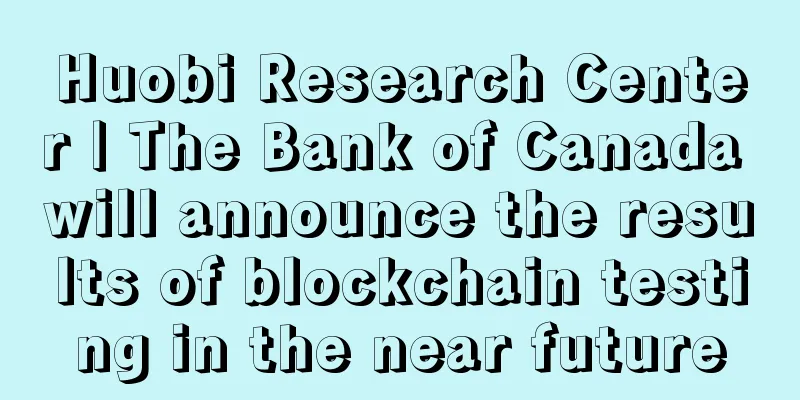Huobi Research Center | The Bank of Canada will announce the results of blockchain testing in the near future

|
According to a report translated by Huobi Blockchain Research Center, the Bank of Canada recently announced that it will release the results of its self-debugging blockchain test in the near future. As part of the project, the Bank of Canada constructed a functional blockchain prototype and a digital token based on legal currency. Canada’s Central Bank Tests Blockchain ProtocolCarolyn Wilkins, senior deputy governor of the Bank of Canada, said the bank has built a new blockchain prototype to test the benefits and risks of the technology. Citing Reuters, the deputy governor said R3 and Payments Canada had also joined the test. Last November, Wilkins praised these emerging innovations in a speech at the University of Toronto's Rotman School of Management. Last summer, Wilkins made it clear that the Bank of Canada and other commercial banks were testing private blockchain technology. She also emphasized the experimental nature of the project, claiming that the Bank of Canada had no intention of issuing its own cryptocurrency. The Bank of Canada will announce the results soonReuters viewed a slide presentation of the bank’s experiment, which showed that the Bank of Canada used legal tender to back the digital currency, so the digital currency could be exchanged for Canadian legal tender at any time. “This is a very practical experiment and we will publish the results of the test sometime in the next few months,” Wilkins told attendees at an event with the Ontario Securities Commission. But Wilkins also emphasized that Canada's legal currency is the foundation and cornerstone of the Bank of Canada's monetary policy. Although the Bank of Canada is very interested in electronic currency, it also helps the bank operate on short-term interest rates, but she believes that Bitcoin is not very "suitable" for monetary policy. So she said:
Traditional banking institutions mainly focus on licensed digital ledgersThrough the Bank of Canada's advocacy, the licensed ledger seems to be more suitable for banking institutions. Many financial institutions are working with companies such as Ripple, R3, and Hyperledger to test centralized federated blockchains. In August, R3 tried two data blockchain prototypes with 15 traditional banks including Wells Fargo, Barclays, BBVA, and BNP Paribas. It’s no surprise that central banks are divided over what Bitcoin has to offer, as opting for a private blockchain solution would give them greater control over their own blockchain networks. The Bank of Canada is another central bank that is researching and developing a distributed ledger framework, while the People’s Bank of China, the U.S. Federal Reserve and other institutions have also shown a keen interest in the technology. |
>>: Xero CEO: It is impossible for banks to implement an immutable blockchain network
Recommend
How does a small earlobe look like? Analysis of the face reading of a small earlobe
Are people with small earlobes unlucky? People wi...
Is it good to have a crooked nose? What's your personality like?
In life, everyone's face is different, and di...
Norwegian millionaire arrested for wife's murder claims to have received $10 million Monero ransom note
According to BlockBeats, Norwegian millionaire To...
Why People Still Believe Bitcoin Will Die
One of Bitcoin’s most compelling properties is it...
A mole determines whether you are a virgin or not. Analysis of cinnabar mole
In ancient times, people attached great importanc...
What does it look like when a woman is greedy for comfort?
I believe everyone has their own pursuits in life...
How to tell fortune by palmistry How to tell fortune by palmistry How to tell fortune by palmistry Pictures and Illustrations
In physiognomy, palmistry is known as the most im...
Is it good for a woman to smile without showing her teeth?
Is it good for a woman to smile without showing h...
Coin Zone Trends: Bitcoin Price Trends Based on Big Data This Week (2017-01-13)
The price of the currency is still under pressure...
Extramarital affair palmistry! How to read the diagram of a man with three marriage lines
How to interpret the diagram of a man with three ...
Your ears tell you how long you will live
Your ears tell you how long you will live Ears oc...
Judging the fortune and misfortune from the palace of noble people in the face
The location of the noble palace in physiognomy g...
Macroeconomic negative factors continue to ferment, Bitcoin may weaken in the short term and test $26,000
After nearly half a month of sluggish consolidati...
Filecoin mainnet is officially launched!!!
The Filecoin mainnet was officially launched toda...
How is the life fortune of people with phoenix eye pattern?
Many people want to know what their future will b...









